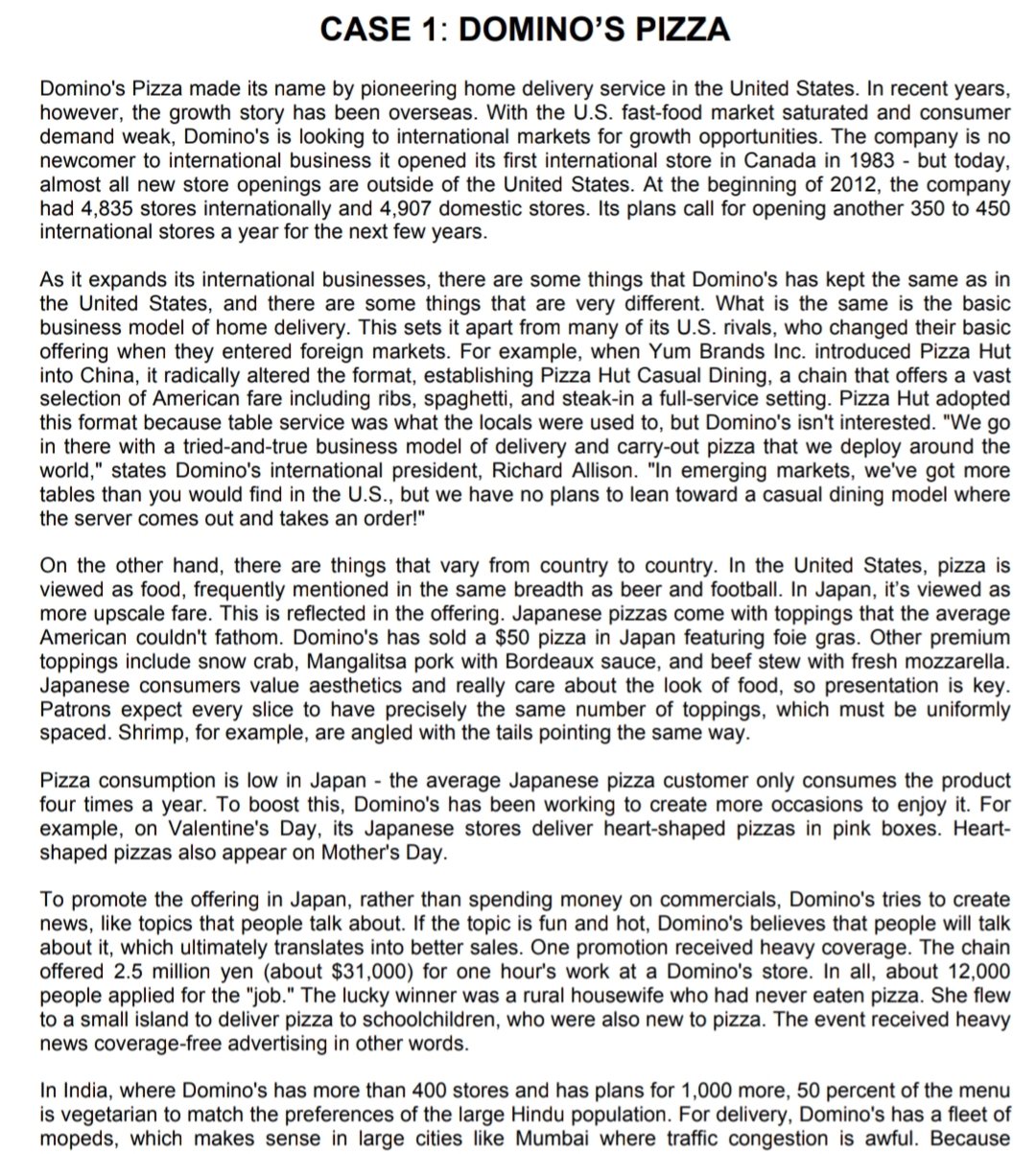Instructions: Read the case provided and answer the question that follows. Question: From an organizational perspective, what do you think Domino's does to make sure that it accommodates local differences in consumer tastes and preferences?
Instructions: Read the case provided and answer the question that follows. Question: From an organizational perspective, what do you think Domino's does to make sure that it accommodates local differences in consumer tastes and preferences?
Chapter8: Business Markets And Buying Behavior
Section8.2: General Electric Goes Social To Reach Business Buyers
Problem 2C
Related questions
Question
Instructions: Read the case provided and answer the question that follows.
Question:
From an organizational perspective, what do you think Domino's does to make sure that it accommodates local differences in consumer tastes and preferences?

Transcribed Image Text:Indians like things spicy, instead of including Parmesan cheese packets, Domino's includes an "Oregano
Spice Mix." In general, the toppings have far more spice than in the United States. Although Indians are
used to full service in restaurants, Domino's doesn't use servers or busboys in their stores, even though
they typically have a few tables in each store for those who want to eat on-premises. Instead, they are
educating their customers to clean up after themselves, with in-store trashcans that say "Use Me" in big
bold letters.

Transcribed Image Text:CASE 1: DOMINO'S PIZZA
Domino's Pizza made its name by pioneering home delivery service in the United States. In recent years,
however, the growth story has been overseas. With the U.S. fast-food market saturated and consumer
demand weak, Domino's is looking to international markets for growth opportunities. The company is no
newcomer to international business it opened its first international store in Canada in 1983 - but today,
almost all new store openings are outside of the United States. At the beginning of 2012, the company
had 4,835 stores internationally and 4,907 domestic stores. Its plans call for opening another 350 to 450
international stores a year for the next few years.
As it expands its international businesses, there are some things that Domino's has kept the same as in
the United States, and there are some things that are very different. What is the same is the basic
business model of home delivery. This sets it apart from many of its U.S. rivals, who changed their basic
offering when they entered foreign markets. For example, when Yum Brands Inc. introduced Pizza Hut
into China, it radically altered the format, establishing Pizza Hut Casual Dining, a chain that offers a vast
selection of American fare including ribs, spaghetti, and steak-in a full-service setting. Pizza Hut adopted
this format because table service was what the locals were used to, but Domino's isn't interested. "We go
in there with a tried-and-true business model of delivery and carry-out pizza that we deploy around the
world," states Domino's international president, Richard Allison. "In emerging markets, we've got more
tables than you would find in the U.S., but we have no plans to lean toward a casual dining model where
the server comes out and takes an order!"
On the other hand, there are things that vary from country to country. In the United States, pizza is
viewed as food, frequently mentioned in the same breadth as beer and football. In Japan, it's viewed as
more upscale fare. This is reflected in the offering. Japanese pizzas come with toppings that the average
American couldn't fathom. Domino's has sold a $50 pizza in Japan featuring foie gras. Other premium
toppings include snow crab, Mangalitsa pork with Bordeaux sauce, and beef stew with fresh mozzarella.
Japanese consumers value aesthetics and really care about the look of food, so presentation is key.
Patrons expect every slice to have precisely the same number of toppings, which must be uniformly
spaced. Shrimp, for example, are angled with the tails pointing the same way.
Pizza consumption is low in Japan - the average Japanese pizza customer only consumes the product
four times a year. To boost this, Domino's has been working to create more occasions to enjoy it. For
example, on Valentine's Day, its Japanese stores deliver heart-shaped pizzas in pink boxes. Heart-
shaped pizzas also appear on Mother's Day.
To promote the offering in Japan, rather than spending money on commercials, Domino's tries to create
news, like topics that people talk about. If the topic is fun and hot, Domino's believes that people will talk
about it, which ultimately translates into better sales. One promotion received heavy coverage. The chain
offered 2.5 million yen (about $31,000) for one hour's work at a Domino's store. In all, about 12,000
people applied for the "job." The lucky winner was a rural housewife who had never eaten pizza. She flew
to a small island to deliver pizza to schoolchildren, who were also new to pizza. The event received heavy
news coverage-free advertising in other words.
In India, where Domino's has more than 400 stores and has plans for 1,000 more, 50 percent of the menu
is vegetarian to match the preferences of the large Hindu population. For delivery, Domino's has a fleet of
mopeds, which makes sense in large cities like Mumbai where traffic congestion is awful. Because
Expert Solution
This question has been solved!
Explore an expertly crafted, step-by-step solution for a thorough understanding of key concepts.
This is a popular solution!
Trending now
This is a popular solution!
Step by step
Solved in 2 steps

Recommended textbooks for you

